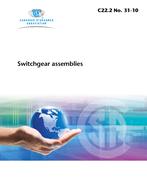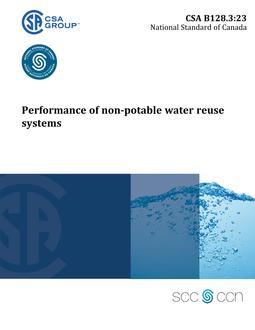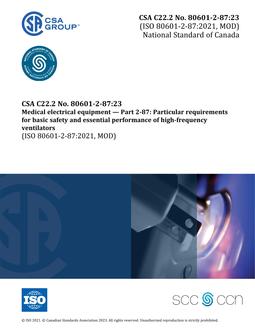
CSA C22.2 NO. 31-10
Click here to purchase
Preface
This is the ninth edition of CSA C22.2 No. 31, Switchgear assemblies, one of a series of Standards issued by the Canadian Standards Association under Part II of the Canadian Electrical Code. It supersedes previous editions published in 2004, 1989, 1983, 1977, 1972, 1965, 1958, and 1939.
Scope
1.1 This Standard applies to deadfront indoor enclosed and outdoor enclosed assemblies of switchgear devices such as (a) switches; (b) interrupting devices; (c) air circuit breakers; (d) power circuit breakers; and (e) control, metering, protective, and regulating equipment with associated interconnections and supporting structures.
1.2 This Standard covers equipment with a nominal voltage of 46 kV or less that is intended to be used (a) in accordance with the rules of the Canadian Electrical Code, Part I; (b) in non-hazardous locations; (c) for controlling and protecting the power from generators or other sources; and (d) for supplying electrical energy to power and lighting circuits.
1.3 General requirements applicable to this Standard are given in the latest edition of CAN/CSA-C22.2 No. 0.
1.4 This Standard does not apply to panelboards, industrial control equipment, switchboards for communication circuits (see the Canadian Electrical Code, Part I), or low-voltage assemblies consisting of separately supported enclosed switches, enclosed circuit breakers, and possibly service meters, with interconnection between them enclosed in raceways. Note: Manufacturers and installers of switchgear assemblies approved under this Standard should take due note of the Canadian Electrical Code, Part I, with respect to the location of switchgear devices in areas where certain components might not be acceptable.
1.5 Clauses 2 to 6 apply to all switchgear assemblies and are supplemented and amended (a) by Clause 7 for low-voltage switchgear assemblies; and (b) by Clause 8 for high-voltage switchgear assemblies.
1.6 In CSA standards, “shall” is used to express a requirement, i.e., a provision that the user is obliged to satisfy in order to comply with the standard; “should” is used to express a recommendation or that which is advised but not required; and “may” is used to express an option or that which is permissible within the limits of the standard. Notes accompanying clauses do not include requirements or alternative requirements; the purpose of a note accompanying a clause is to separate from the text explanatory or informative material.
Notes to tables and figures are considered part of the table or figure and may be written as requirements. Annexes are designated normative (mandatory) or informative (nonmandatory) to define their application.
Product Details
- Edition:
- 9th
- Published:
- 09/01/2010
- ISBN(s):
- 9781554915194
- Number of Pages:
- 64
- File Size:
- 1 file , 1.7 MB
- Product Code(s):
- 2420775, 2420775


